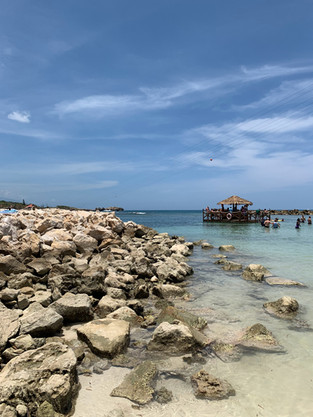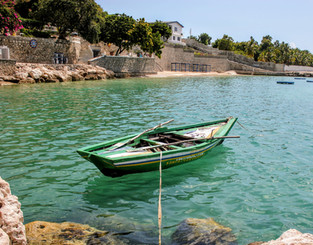Travel to Haiti: First Impressions
- LR Blanc
- Apr 25, 2021
- 10 min read
By: Audrey Scott

Haiti. It’s a country that most people today still associate with earthquakes, coups, and unrest – a sort of irretrievable chaos. Before traveling to Haiti, we knew very little about the country. Even after performing our own research — let’s face it, there’s little information on Haiti beyond the headline news – we weren’t quite certain what we would find, experience or feel while there.
Haiti is complicated. Even Haitians will tell you that. Each time we thought we grasped something about Haiti, another event would intervene that would help us realize we had only just peeled back one layer of our understanding of the Haitian cultural onion. And that’s what makes Haiti so fascinating: it tempts one to question, to experience, to learn and to re-learn – an invitation to penetrate as closely as a visitor might to its innermost layers.
When we shared photos and updates while on our tour to Haiti, readers would respond: “Is that really Haiti?”
Welcome to Haiti. Time to become a little more familiar – with the everyday, the exceptional and the forces to be continually reckoned with.
1. Travel Safety in Haiti
Time to dispatch the elephant in the room. When we first announced we were headed to Haiti, responses of concern were not only common, but they often spelled expectations of doom. One reader, to wit, offered this: “I hope you survive.”
There’s no denying Haiti has historically experienced its share of instability over the decades. Between 2004 and 2006, kidnapping of wealthy Haitians, international executives and aid workers was common. In the aftermath of the 2010 earthquake, crime and assaults increased. But as our visit to Rwanda earlier this year demonstrated, countries are not forever suspended in time: they change, they evolve, and many, quite thankfully, move on.
As foreign travelers in Haiti, we surprisingly never felt targeted or at risk – neither in the peace of its mountains or the din of its cities. It is true that much of the time we were with a group or with others, but even when Dan or I often peeled off to engage with people, explore markets and meander down side streets on our own, we did not feel anything menacing.
Of course, common sense and basic safety measures still apply. As in most countries (including my own, the United States), I would not wander inner city streets alone at night. As taxis are surprisingly uncommon in Haiti, even in cities such as Port-au-Prince, I would arrange return transport in advance so as not be stuck without a way back to wherever I happened to be staying.
If you pack some developing world travel sense and especially follow the advice outlined in #3 below, you’ll likely find yourself feeling pretty comfortable with Haiti and its people.
2. A Land of Mountains
Despite the fact that the word Haiti means “mountainous land,” we envisioned only a few hills here and there. Instead, the country is defined by layers of mountains.
We managed a glimpse of this on our flight approach to Port-au-Prince, but our first on-the-ground taste occurred on our hike up to La Citadelle Laferrière near the town of Cap-Haïtien in northern Haiti.
Our appreciation of Haiti's landscape was complete with our hike up to Pic la Selle, Haiti’s highest mountain, and through nearby Parc National La Visite.
It’s no wonder that Haitians say “Dèyè mon gen mon.” (Behind the mountain, there are mountains.) This Haitian proverb proved one of my favorites, as it’s not only appropriate to the country’s landscape but also metaphorically fitting to the country’s history and circumstances. “There is more than meets the eye” repeatedly rang true during our visit to Haiti.
3. “A greeting is your passport.”
“Bonjou se paspò ou,” is another of a raft of available Haitian proverbs, one we learned early and put into practice often during our trip. Simple gestures such as saying “bonjou” (hello in local Kreyòl), offering a smile and nodding in respect tends to open doors of good will. Perhaps this is obvious advice, a generally accepted good travel principle, but it is particularly relevant to Haiti.
On the surface, Haitians can sometimes show a stern, skeptical look that might not feel particularly welcoming at first glance. However, a respectful greeting and smile can help break down that tough exterior, thereby reducing some of the distance between you as the blan (literally meaning “white,” but slang for foreigner) and local people.
Haitians are a social bunch. Perfect strangers call each other cheri meaning “my dear” (I loved when I was referred to this way). With monikers like this, Haitians transform the atmosphere from the appearance of something serious to something more open and laughter-filled in a matter of moments.
It's also important to note that, in general, Haitians don't especially invite or seem to enjoy having their photograph taken. It's completely understandable given that there has been a string of photojournalists who have focused mostly on negative aspects of the country; people are tired of that. Best to store the big camera and lens until you've established a bit of a rapport, ask for permission and have some fun with the process by showing the image afterwards.
4. Vodou in Haiti
Often when people think of Vodou (or Voodoo, as we foreigners like to spell it) they imagine the Hollywood-branded version: pins stuck into a voodoo doll, evil curses placed, zombies roaming the earth. Perhaps it does not come as a surprise when we say that Vodou in reality seems a far cry from this.
We were fortunate to spend time with a Vodou hougon (priest) who was open to answering questions about his practice and spirituality when we visited his ounfo (temple). Vodou in Haiti is a complex belief system that blends traditions and practices from West Africa, carried by slaves brought over during the 17th-19th centuries, with colonial Catholicism and a few local twists. At the core of Vodou are the lwa, spirits which serve as intermediaries to assist human beings to communicate and connect with a single, distant God.
There are hundreds of lwa, divided elaborately into societies. Each has his or her own characteristics and symbolism and ways in which they wish to be served. During a Vodou ceremony, a lwa will be summoned, and will often take over the body of someone present in order to provide spiritual and physical guidance and healing. A certain brand of emotional rawness is at work that yields an appreciation that death and life are in fact bound close together.
As one hougon explained to us: “Vodou, it is what you cannot see that is all around you.” The suggestion: our practice only manifests what is already there.
Once you comprehend this, you’ve set off on the road to understand Vodou and the Haitian approach thereto.
Note: If you are interested to learn more about Vodou and its practice in Haiti, consider reading The Serpent and the Rainbow by Wade Davis.
5. Renegade Artists
Haitians demonstrate a remarkable artistic expression. Where this is most obvious is in veins of renegade artist communities such as Atis Rezistans, a group of avant-garde artists who live and create along a segment of Port-au-Prince’s Grand Rue. André Eugène and Jean Hérard Céleur, the founding artists of Atis Rezistans, broke tradition by cultivating a censorship-free artistic expression that defied social norms. Almost 15 years later, Atis Rezistans operates as a collective guided by a philosophy of sharing and support that trains young artists through its Ti Moun Rezistans program.
To me, the feeling in this artist community is one of undressed emotion and unfettered expression. It’s clear in the atmosphere and also apparent in the works themselves.
On the surface, the art appears to exist as if to shock, particularly to a visitor like me. But it becomes apparent that the intention of their work is to stand as an emotional interpretation of a cycle of life to death, with all the requisite fears, dreams, and sex that make us human laid bare.
Artists rely heavily on recycled materials, lending a sense of re-packaging and re-purposing of emotion. Discarded items are incorporated, life’s detritus finds new life. And maybe even new hope.
“There is no death without life…there is no art that is not a liberation of the force of life. And when death is around you all the time, you try to profit from every day of life.” – Romel Jean Pierre, an artist and filmmaker at Atis Rezistans.
6. Everything tastes better with a few chili peppers, even peanut butter.
We knew almost nothing about Haitian cuisine prior to our visit, so we look forward to writing about it in depth and sharing it with you very soon. One of the facets of Haitian food that we especially enjoyed is its occasionally liberal and often creative application of spice and employment of chili peppers. As evidence, witness spiced peanut butter whereby a Scotch Bonnet or Habanero pepper is a thrown in with a batch of ground peanuts.
“OK, heat in food I get. But spicy peanut butter?!?”
Yes. And we can attest to its goodness.
Throw in Haitian hot chocolate, grilled lobster, plenty of beans, odd greens, breadfruit, avocados and dark rum and you have the making for some culinary joy.
But you’ll just have to wait for our Haitian food throw-down to hear more about all of it.
7. A Country Rich in Proverbs
No two ways about it, Haiti has a way with words. Its proverbs are deep and funny, often sad, sometimes crude, always clever. It occurs to me that Haitian proverbs are a manifestation of the country’s narrative, a form of storytelling, evidence of the importance of oral tradition in Haiti in sharing wisdom and lessons.
A day couldn't go by when we’d question or notice something and hear in response: “We have a saying for that in Haiti.”
The proverb shared was usually one with a story behind it that helped peel back for us another layer of the cultural complexity that is Haiti — one part quirky and another dark, evincing a certain pliability or resilience that almost seems required of Haitian people given their country’s history. Honesty and a bit of reflective self-deprecating humor, too.
Even when things are bad, rise up a proverb to place it all in perspective and shed some honest light on all that we humans do, good and bad.
Here are a few of my favorites:
Note: We learned these through English translations; we imagine the versions in their original Kreyòl are even better.
“Lang pa lanmè, men li ka neye-w.” — The tongue is not the sea, but it can drown you.
“Bourik swe pou chwal dekore ak dentel.” — The donkey sweats so the horse can be decorated with lace.
“Avèk pasyans w'ap wè tete foumi.” — With patience, you can see the tits on an ant.
If you are interested in further availing yourself of Haitian wisdom through its proverbs, here is a great list.
A note on language in Haiti: French is the language of schools and government, but Haitian Creole (Kreyòl) is the language of the people.
Although one could argue that Kreyòl is French-based, the differences between the two are greater than their similarities. You’ll notice some common words and vocabulary, taken from French and employed in Kreyòl, but Kreyòl is spelled differently than French and is more phonetic. Beyond that, the structure of the languages is quite different.
8. 2010 Earthquake Recovery, International Aid
A common question asked of us since returning from Haiti: Can you still see the effects of the 2010 earthquake? (The catastrophic one centered near Port-au-Prince that killed an estimated 220,000 people.)
As you walk around downtown Port-au-Prince, buildings that were destroyed by the earthquake remain abandoned. In the city’s Champs de Mar area where the Palais National once stood, the square is filled with red corrugated metal construction walls.
But life goes on. It must. The central market, the Marché en Fer, was destroyed but has been rebuilt. Vendors have returned, new communities have emerged in the ruins of others. Haiti is very much an example of rebirth in the face of devastation and destruction.
You can still find a prominent international aid presence in Haiti; some organizations were there before the earthquake, others arrived afterwards and haven’t left. As anywhere in the world where a large donor-funded international aid presence exists, you can feel the draw of a double-edged sword. The flow of donor money to help in Haiti’s recovery has done a lot of good. However, big aid begets pockets if not a prevailing attitude of dependency and reliance on foreign handouts that paradoxically crowd out local solutions and create distortions in the local economy for real estate and other goods. Help is needed, but so is the idea that the citizens of Haiti must also find solutions that are suited to their own needs and context.
Haiti is clearly a fertile country. It’s disappointing to see it depend so much on imported food when one imagines it could produce so much itself. We sincerely hope that the will exists to pursue long-term investments in education, infrastructure and agricultural reform.
Easier said than done, we know. But we can see the potential.
9. Haitian Music and the Singing President
“No matter what we do we have the drum. When we have problems we sing and dance, when we are happy we sing and dance. There's always the drum in Haiti” – Maurice Etienne, Lakou Lakay Cultural Center
Music is infectious in Haiti; rhythm seems deep in the bones. Drums and dancing are integral to Vodou ceremonies and practice, but the love of and prevalence of music carries to all aspects of life. It's not uncommon to see workers unconsciously incorporating a few dance moves here and there as they stock shelves or work the market while listening to local music.
Haiti's current president, Michel Martelly, is also a famous musician. Known better as Sweet Micky, Martelly and his band play konpa, a style of Haitian music derived from local Méringue (similar perhaps, but not the same as Dominican Merengue) that further blends Haitian folk music with an imprint of American jazz leftover from the U.S. occupation from 1914-1934.
One of our best memories of Haitian music involved the kitchen staff at Auberge La Visite in the mountains near Seguin. They listened to konpa endlessly. We found ourselves drawn into the kitchen to find out the name behind the catchy tunes and infectious rhythmic earworms — 30-minute long ball renditions of classic konpa — that consumed the building. Although the origin of these tunes is up for discussion, the voice most often behind what we heard: Sweet Micky.
(Note: If you happen to be in Port-au-Prince area on a Friday night be sure to go by Presse Café for a live konpa band and a wide open dance floor.)
10. Haitians Love Their Lottery
Everywhere you go in Haiti, from the tiniest of villages to the biggest of cities, you will see plenty of colorful outposts labeled bank. My initial thought: a vast and highly competitive micro-credit industry in Haiti?
I was later informed these were borlettes, or Haitian lottery outlets. Lottery, it turns out, is a national pastime. For legitimacy, lottery numbers in Haiti are based on New York Lotto numbers, drawn twice daily. As one Haitian we met put it, “Are you kidding? No Haitian would trust numbers drawn here in Haiti!”
The idea: you purchase a hand-signed ticket indicating your choice of a series of 2-digit numbers. From there, a complicated betting option exists where you can “marry” your numbers together for bigger winnings should you guess correctly more than one number. Although I didn't quite fully understand my betting options and the mathematical gymnastics embedded therein, I placed a bet on three numbers and purchased a double marriage to ensure I’d win the maximum were I to choose all three numbers correctly.

























































































Comments